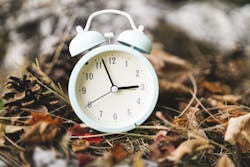It's time to "fall back" to standard time and time to think about safety at work and at home.
"The time change has been known to leave many of us feeling fatigued, which can pose some safety risks at home and at the office. On the other hand, the time change can be a natural reminder of a few things we can do to make our lives safer," says Kathy Konicki, Nationwide safety director.
A few things to remember about the switch back to standard time at 2 a.m. Saturday night:
- Fatigue. Studies suggest that it takes people who work traditional hours several days to fully readjust their sleep schedule after the time change. Researchers report that adapting to the spring time change is more difficult than facing the end of Daylight Saving Time in October. "Regardless, there is a physiological consequence to changing our clocks. So don't be surprised if you feel a bit sluggish for the first week or so of November. It is normal and the feeling should pass relatively quickly," Konicki says.
- Accidents. Evidence suggests that time changes increase safety problems at work and at home. For example, studies have documented a 3.5% to 10% increase in traffic crashes during the week that follows the time change. "Just being aware of the increased risk of accidents in the period immediately following the time change may help you stay alert," Konicki says. "Remember to avoid building up a sleep debt in the days before the change."
- Home safety. This is a good time to check batteries in smoke and carbon monoxide detectors. Changing batteries twice each year, at the time change, ensures that the detectors will work properly in case of an emergency.
Daylight saving is the system of setting clocks one hour ahead so sunrise and sunset occur at a later hour, producing an additional period of daylight in the evening. Energy savings is the big incentive for using Daylight Saving Time, trimming the nation's electricity usage by about 1% each day.
During World War I, the daylight-saving system was adopted to conserve fuel needed to produce electric power for the war. With the uniform Time Act, Congress in 1966 established a system of uniform daylight-saving time throughout the United States and its possessions. States in which the legislatures voted to stay on standard time were exempted. Arizona and portions of Indiana have opted out of Daylight Saving Time.
Daylight Saving Time begins at 2 a.m. on the second Sunday in March and ends at 2 a.m. on the first Sunday in November.
The fall time change will expose people to more debilitating artificial light because the work day may not be over once the sun sets an hour earlier.
Headaches, eyestrain and increased irritability many people experience today may be caused by artificial light. This light comes from cool-white fluorescents and computer screens.
Those are not the only problems these lights may be causing. Most people do not realize scientific tests prove that common cool-white fluorescents affect emotional, physical and mental well-being.
Most office and institutional buildings use the outdated cool-white fluorescent bulbs. The narrow-light spectrum (unnatural light) and the flicker these older bulbs and ballasts produce, along with the flickering light computer screens generate, play havoc on eyes and produce negative physiological effects.
This is confirmed by recent ergonomic studies conducted by the Christian Bartenbach Group in Innsbruck, Austria. The National Institute of Occupational Safety and Health indicated that 88% of the people who work at computers for more than three hours a day suffer from symptoms of eyestrain.
In addition, studies obtained at the University of Iowa Medical Library, the American Optometric Association and several other sources show that light affects us physically and mentally.
Scientists believe we should design artificial lights that are as close as possible to natural sunlight. Scientists urge us to replace narrow-spectrum, cool-white bulbs with full-spectrum fluorescents, sometimes referred to as "true light" or a natural type light.
Two remedies that provide relief:
- Full-spectrum fluorescent bulbs. These provide the natural type of light scientists recommend. Because they increase the contrast inherent in this type of lighting, fewer bulbs can be used where lighting needs to be less, in particular, around computer stations.
- High-quality monitor glare guard or filter. This includes anti-glare products using tempered glass and HEA(c) coating, the highest performing anti-reflection coating available.
